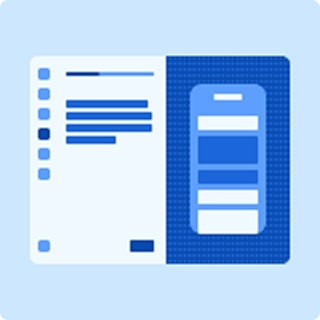UX Research Glossary
a
b
c
d
e
f
g
h
i
j
k
l
m
n
o
p
q
r
s
t
u
v
w
x
y
z
A
A/B Testing
A/B testing (also called split testing) is a UX research method that compares two versions of the same design, copy, or CTA to determine which performs better.
Accessibility
Accessibility in UX is the practice of designing products and digital experiences so they can be used by people of all abilities.
Affinity Diagram
An affinity diagram helps designers, researchers, and project managers organize large amounts of qualitative data, information, and ideas, into meaningful categories based on similarities or themes.
Attitudinal Methods
Attitudinal methods refers to research approaches and techniques that focus on people’s attitudes, beliefs, and opinions about a product, service, or digital experience.
B
Benchmark Study
A benchmark study is a research method that measures a product or service’s usability against a predefined standard, baseline study, or industry best practices.
C
CXO
A Chief Experience Officer (CXO) is the C-level executive responsible for the end-to-end experience people have with a company’s products, services, and brand.
Card Sorting
Card sorting is a UX research method in which participants group labeled cards into categories that make sense to them.
Clickstream Analysis
Clickstream analysis is the process of tracking and analyzing the sequence of clicks a user makes on a website or product.
Cognitive Load
Cognitive load refers to the mental effort required to process information and complete a task.
Confidence Intervals
A confidence interval is the probable range for the true score of an entire population (typically your user or customer base).
Content Design
Content design is the practice of creating and structuring the content inside a product based on real user needs.
Contextual Inquiry
Contextual inquiry is a UX research method where researchers observe users in their natural environments like their office or home, to see how they interact with a product.
Customer Effort Score (CES)
Customer Effort Score (CES) is a customer experience metric that measures how easy or difficult it is for customers to complete a task or solve a problem during an interaction with a business.
Customer Experience
Customer experience (CX) refers to the overall perception that a customer has of a brand.
Customer Feedback Loop
The customer feedback loop refers to the process of collecting customer feedback, analyzing it for insights, acting on those insights, and returning to customers for their feedback on changes.
Customer Journey
The customer journey is the path of interactions that customers have with your organization. It refers to all the touchpoints they encounter before, during, and after the buying process.
D
Design Sprint
A design sprint is a time-constrained, intensive, five-phase process used to to quickly solve problems, develop ideas, and reduce risk when bringing a new digital experience to the market.
Design Thinking
A user-centered, iterative design approach that helps design teams focus on user needs, challenge assumptions, and redefine solutions to explore innovative designs for prototyping and testing.
Diary Study
A qualitative user research method in which participants log entries— typically in written diaries, voice notes, or digital tools—to document their experiences with a product or feature.
E
Empathy Mapping
Empathy mapping is a collaborative process designers use to understand and visualize what a user says, thinks, does, and feels in relation to a product or service. The process allows design teams to gain a better grasp of user pain points, motivations, and desires.
Ethnographic Research
Ethnographic research is a qualitative research method that involves observing how participants interact with a digital experience while in their natural environments.
Eye Tracking
Eye tracking is a UX research method that uses specialized cameras or sensors to record where users look and how long they focus on different elements.
F
Field Study
A field study is a qualitative UX research method where researchers observe and interview users in their real-world environments—such as their homes, workplaces, or public spaces.
First-Click Testing
First-click testing evaluates the intuitiveness of a design is by tracking the first place a user clicks to complete a specific task, such as finding customer support or accessing a specific feature.
Focus Group
A focus group is a qualitative research method in which a small group of participants (typically 6-10) discuss a product, service, or idea guided by a moderator.
H
Heatmap
A heatmap is a visual representation of user behavior that results from tracking interactions—such as clicks, scrolls, or cursor movements—across a website or product.
Heuristic Evaluation
Heuristic evaluation is a UX research method that's used to identify issues regarding product usability and user interface design.
High-Fidelity Prototype
High-fidelity prototypes are highly functional and include design details and real content that simulate what the end product will look like.
I
Ideation
Ideation is the first stage in the UX design and development process. It involves generating ideas for improving existing products or developing new ones.
Information Architecture
Information architecture is the structural design of the information on a website or product.
J
Jobs to be Done (JTBD)
A job to be done is a statement that describes what a user or group of users are trying to achieve in a specific situation or environment.
Journey Mapping
Journey mapping is the process of outlining and evaluating the steps a user takes to accomplish a goal.
L
Lean UX
Lean UX is an approach to user experience design that prioritizes collaboration, fast iterations, and continuous feedback to create user-centered products.
Likert Scale
A Likert scale is a rating scale used in customer surveys that asks users to choose to what degree they agree or disagree with a statement or set of statements.
Longitudinal Study
Longitudinal study is a research method that collects data from the same participants repeatedly over a period of time.
Low-Fidelity Prototype
A low-fidelity prototype is a basic version of a product, typically used in the early stages of design.
M
Market Research
Market research is the process of gathering insights about potential customers, competitors, and the market to guide product decisions.
Mental Model
A mental model is the representation of a user’s expectations of how an interface should behave based on their knowledge, assumptions, and prior experiences with similar systems.
Microcopy
Microcopy refers to small snippets of text that guide users through an interface.
Minimum Viable Product
A minimum viable product (MVP) is the simplest version of a product that delivers core functionality to early users.
Moderated Testing
Moderated testing is a research method in which a facilitator (moderator) works directly with participants during a research study, guiding them through tasks or activities while observing and interacting in real-time.
Moderated Usability Testing
Moderated usability testing focuses specifically on evaluating how users interact with a product’s interface to assess ease of use, identify pain points, and gather feedback for improving usability.
Multivariate Testing
Multivariate testing is a UX research method that involves testing multiple variations of a design and its components to ascertain which combination of variables performs best.
N
Net Promoter Score (NPS)
Net promoter score is a customer experience metric that measures customer loyalty and satisfaction.
O
Onboarding
Onboarding in UX is the process of introducing new users to your product. It involves educating customers on how to use your product while simultaneously highlighting its value to encourage product adoption.
P
Prototype
A prototype is a preliminary version of a product or system design used to test and validate ideas before full-scale production.
Q
Qualitative Research
Qualitative research is a type of research that explores non-numerical data to understand people's thoughts, feelings, and behaviors.
Quantitative Research
Quantitative research is a research method that collects and analyzes numerical data—such as survey responses, test scores, sales figures, or demographic statistics—to identify patterns and relationships.
R
Rating Scales
Rating scales are closed-ended, multiple-choice questions where each answer holds a particular value (e.g. 1 to 10, good to bad).
Remote Testing
Remote testing refers to any user or product testing in which the participant and the researcher are in different geographical locations.
Remote User Testing
Remote user testing is a usability testing method in which the participant and the researcher are not in the same physical space, such as an office or lab environment.
Research Operations
Research Operations, or ResearchOps, refers to the processes, tools, and strategies that support the smooth execution and scaling of the UX research discipline within an organization.
S
Sentiment Analysis
Sentiment analysis (SA), also called opinion mining, is a technique to classify user feedback into positive, negative, or neutral categories.
Service Design
Service design is a multidisciplinary approach to planning and coordinating all the elements of a service to ensure it works smoothly for both users and providers.
Session Replay
A session replay is a reconstructed presentation of how users interact with a website, app, product, or service.
Snowball Sampling
Snowball sampling is a non-probability recruitment method where existing participants help recruit others who fit the study criteria.
Statistical Significance
Statistical significance shows whether a difference in quantitative results—like task completion times between two designs—is likely due to the design itself, not random chance.
Survey
A survey is a research method that collects data by asking participants structured questions.
Synthetic user
Synthetic users are AI-generated representations of users, designed to mimic the behavior, preferences, and interactions of real human users within a digital product or interface.
T
Task Analysis
Task analysis is a UX method used to break down and understand the steps users take to complete a specific task within a product.
Task Scenario
A task scenario is a narrative description used in usability testing to give participants context for a specific task they need to complete.
Think-Aloud Protocol
The think-aloud protocol is a qualitative research method in which participants verbalize their thoughts, feelings, and decision-making processes as they complete a usability testing task.
Tree Testing
Tree testing is an information architecture testing method that’s used to assess the findability of resources and navigability of your product.
U
UMUX
UMUX (usability metric for user experience) is a standardized questionnaire that measures the perceived usability of a system or product.
UX Metrics
UX metrics are measurements that evaluate how users interact with a product or service to help teams understand user behavior, customer satisfaction, and product usability.
Usability Heuristics
Usability heuristics are a set of guidelines and principles for designing user-friendly products, features, and experiences from the get-go.
Usability Testing
Usability testing is a UX research method that involves observing how users complete a task in order to assess the usability and functionality of a product or feature.
User Experience (UX)
User Experience (UX) refers to the overall experience an individual has when interacting with a product. UX includes how easy and enjoyable it is to use the product, as well as the emotions and perceptions users have during their interactions.
User Flow
A user flow is a visual representation of the path a user takes while interacting with a product or feature.
User Journey
A user journey (also called a customer journey) refers to the sequence of actions taken by a user to achieve their goal within a product or app.
User Onboarding
User onboarding is the process that helps new users get started with a product or service. It guides them through initial setup, introduces key features, and ensures they understand how to use the product effectively.
User Persona
A user persona is a semi-fictional representation of a segment of your target audience.
V
Visual Hierarchy
Visual hierarchy is a design principle that states that elements on a page or interface should be organized based on their importance.
Voice of the Customer (VoC)
Voice of the Customer (VoC) is a customer experience research strategy that collects and analyzes customer feedback to understand their needs, preferences, and experiences.
W
Wireframe
A wireframe is a simplified visual representation of a product’s design and user interface. It consists of simple lines and shapes that outline the skeleton of a design—typically including the product’s layout, structure, and functionality.
Wizard of Oz
Wizard of Oz (WoZ) is a moderated UX research method in which users interact with a design that’s controlled by a person.


